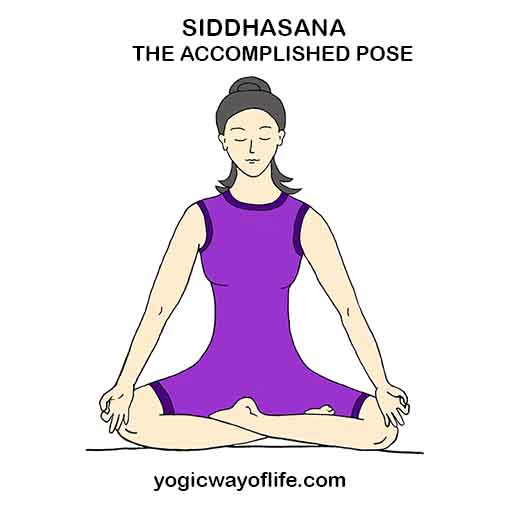Siddhasana or the accomplished pose is an asana used for meditation and other yogic practices. In Sanskrit ‘Siddha’ means ‘accomplished’ or an ‘adept’ and ‘asana’ means a ‘pose’. Siddhasana is mentioned in the Hatha Yoga text Hatha Yoga Pradeepika as one of the four most powerful sitting poses suited for meditation.
For practitioners of meditation, the importance of Siddhasana is only second to Padmasana or the lotus pose. In fact, some claim Siddhasana to be the best of all asanas for meditation. In Hatha Yoga Pradeepika, it is said that a yoga practitioner should always practice Siddhasana, among the 84 asanas. The text says that practice of Siddhasana purifies all the 72,000 nadis or energy channels in the body, through which the prana flows. It also says that by contemplating on one’s Self, eating moderately and practicing Siddhasana for 12 years, one can attain success in yoga.
This asana can be practiced by anyone, except those suffering from sciatica or sacral infections.

How to do Siddhasana (The accomplished pose)?
- Sit on the floor with legs close to each other.
- Take the left foot and place it at the perineum. The perineum is the soft tissue between the anus and the testis. For females, it is done differently. Females should place the left foot in the labia majora of the vagina.
- Now take the right foot and place it over the left foot.
- To make the posture steadier, slide the right foot toes into the space between the left calf muscles. This may require some adjustment to the position. It is like creating a lock, so that the lower body is stable for long durations of meditation.
- The knees should touch the floor.
- Now, make your spine straight.
- The chin can press against the chest.
- Gaze at the space between the eyebrows. And become aware of your breathing process. The breathing can be natural and deep. One may also practice Ujjayi breathing according to one’s meditation technique.
- The hands can be kept on the knees. One may assume the Chin Mudra or the Jnana Mudra with the fingers, if one wishes.
- Maintain this position for as long as you are comfortable.
Benefits of Siddhasana (The Accomplished Pose)
- Siddhasana is one of the main poses used for meditation. One can maintain this position for a long duration. Those who have difficulty practicing Padmasana can easily practice Siddhasana for extended periods. This asana holds the spinal column straight and steady.
- In Siddhasana, the heel is kept pressed against the Mooladhara chakra. This ensures that the energy currents flow upwards towards the spine.
- The position of the heels also stimulates the lower two chakras Mooladhara and Swadhistana. The sexual energy is channelized upwards and converted into subtle energy called ‘ojas’.
- It also gives the practitioner control over his sex urge and the sexual functions.
- In Hatha Yoga Pradeepika, it is said that Siddhasana stabilizes the nervous system by calming down the pranic energy.
Contraindications for Siddhasana (The Accomplished Pose)
- Siddhasana shoulde not be done by those suffering from sciatica and sacral infections.
